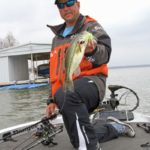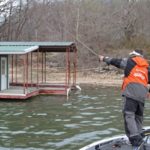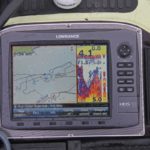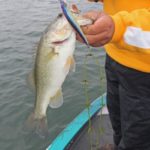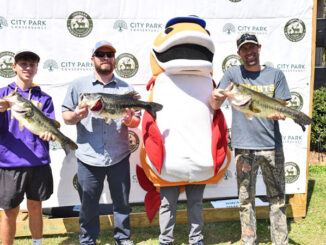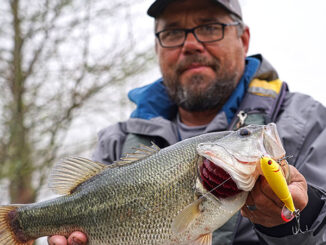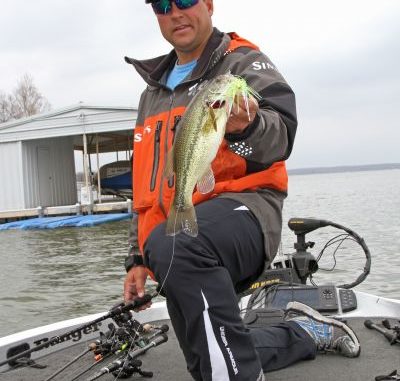
The bass spawn is fast approaching, but unpredictable spring weather can make consistently limits difficult. Here’s how the pros overcome the challenge.
There’s a fine line between prespawn and spawning movement — get it wrong and you’ll be wasting time by fishing ahead of or behind the fish.
But get it right and it can be a lights-out deal.
Experienced anglers know that finding fish and determining their positioning can be a day-to-day deal, depending on lunar and meteorological factors.
There’s no one-size-fits-all formula, so let’s look at a handful of tips from anglers who chase bass for a living.
The waiting room
Prespawn fish will stage on the last line of structure outside spawning grounds, and FLW Tour pro Greg Bohannon said that makes it possible to establish patterns that are replicable throughout the lake.
Are they just outside the mouths of creeks or spawning pockets? Are they right on those points? Are there any particular features like wood or docks that bass seem to like?
Paying close attention to where strikes occur will provide a template for subsequent stops — as long as conditions remain relatively stable, the fish typically show predictable preferences.
Bohannon illustrated this during a prespawn trip when he picked up a solid keeper in about 2 feet of water on a jerkbait while working down a stretch of bank outside a spawning pocket.
The bite came just one cast from turning the corner.
“That fish was up there next to a piece of wood,” Bohannon said. “I threw up there, jerked it once and my line jumped. He was right up there where he should be — right up there on the point, right where they should be right now, getting ready to move back into the pockets.
“That told me I need to stick closer to the mouths of the creeks. So I’ll jump around to some other spots that are similar.”
Notably, Bohannon said that, no matter where he thinks the fish are in their general spawning movement, a lone dock or boat shed at the back of a pocket is like a magnet. Pitching a jig around the corners or running a spinnerbait down the sides of such structure often rewards inquisitive types with a bonus bite.
Here are some other factors to consider:
• Eye in the sky — Toledo Bend guide Stephen Johnston expects a major spawning wave on the new and full moons; however, he knows fish don’t always follow the script.
So if the water’s warm enough, he’ll check the bank for any shoreward movement between the big moons.
• Showers of hope — Bassmaster Elite pro Jason Christie knows an early spring rain makes for some uncomfortable fishing the day it falls, but shortly thereafter comes a period of shallow stimulation.
“Whenever you get a good rain in the early spring, all those fish that are holding out deep are going to run to the bank,” Christie said. “It’s the combination of stained water and the warm runoff that will trigger those fish to move up.”
Key habitat
When you’re on the water, it’s often tempting to head to the banks for the simple reason that there are visible targets. But touring pro anglers know that’s not the most-productive choice for the prespawn.
So here are some thoughts on specific areas on which to focus:
• Don’t get stumped: FLW Tour pro Pete Ponds is a big fan of cypress stumps because they could serve fish in different stages of the reproductive process.
“On deeper stumps, the fish might stage there for the prespawn,” Ponds noted. “But if the stumps are in shallow water in the backs of the pockets, then the bigger fish like to spawn on the root structure.”
• On point — FLW Tour pro J.T. Kenney said a broad field of sparse grass holds loads of prespawn potential because fish will fill the areas during warming weather.
But in the year’s early goings, the scattered fish require a cat-and-mouse hunt.
So Kenney drops a waypoint each time he catches a fish. After working a broad area, a quick look at those dots on his chart plotter often reveals a pattern of depth range, habitat preference, etc.
It’s not too hard to replicate another productive pass once you have a clear picture of where they’re holding.
• Slim chance — The thin, stalky remnants of seasonally departed lily pad fields might not look like much, and they’re easily overlooked.
But Kenney confided that this can be a slam-dunk prespawn deal. Maybe the fish are working off memories of last year’s pad growth and maybe they’re finding a certain forage item —but any way you cut it, barren stems should always merit a few casts.
• Creek sneak — In somewhat of a micro version of Bohannon’s explanation of spawning pocket positions, FLW pro Phil Marks always sends a few pitches toward small canals opening into larger creeks.
Points at the mouths are often good staging areas, especially where wood or brush enhances the habitat.
Feed the big girls
Bassmaster Elite Series pro Terry Scroggins said the good thing about prespawn fishing is that bass are at their fattest point of the year — so the chance of catching a personal best is pretty high.
Add to that the accelerated appetites of soon-to-be-bedding females, and Scroggins expects to catch prespawners on a variety of presentations.
His favorites approaches include pitching a YUM Wooly Bug under a 1 ½-ounce tungsten weight, walking a Zara Spook or Smithwick Devil’s Horse in open lanes amid vegetation and targeting grass edges or lily pads with a weightless Texas-rigged YUM Dinger.
FLW’s Greg Bohannon likes using a jerkbait and an Alabama rig to find the hot prespawn zones on which he then focuses with crankbaits, spinnerbaits and jigs.
Scroggins also likes a grass-lined channel edge just outside spawning flats because he might find prespawners in two different positions: Some might be holding on that first break, while others may be relating to the grass itself — sometimes tucking right into the vegetation.
Water temperature and sky conditions typically determine where the fish will position, but in either case twitching a Smithwick Rogue over the edge will tempt the fish with an easy meal.
Around grass edges, Bassmaster Elite Series pro Cliff Crochet of Pierre Part likes mixing up his presentations with a swimbait and a swim jig.
The former gets the call when fish are aggressive, but if the bite’s less than enthusiastic — or if he just needs to clean up after catching a few swimbait fish — that swim jig’s more subtle presence can be a dandy prespawn bait.
Elite Series pro and swimbait aficionado Chris Zaldain brings a bold approach to the southern prespawn: For him, it’s often go big or go home, so he won’t hesitate to launch a Megabass I-Slide 185 toward a shallow dock or cypress trees where he suspects big fish are holding.
“I like the silver salmon color because it represents those big gizzard shad,” Zaldain said. “I can cast that bait far, speed it up, slow it down or kill it to get a reaction bite.
“I’ll rarely catch a five-fish limit on it, but when I need a big bite or two this is what I throw.”
